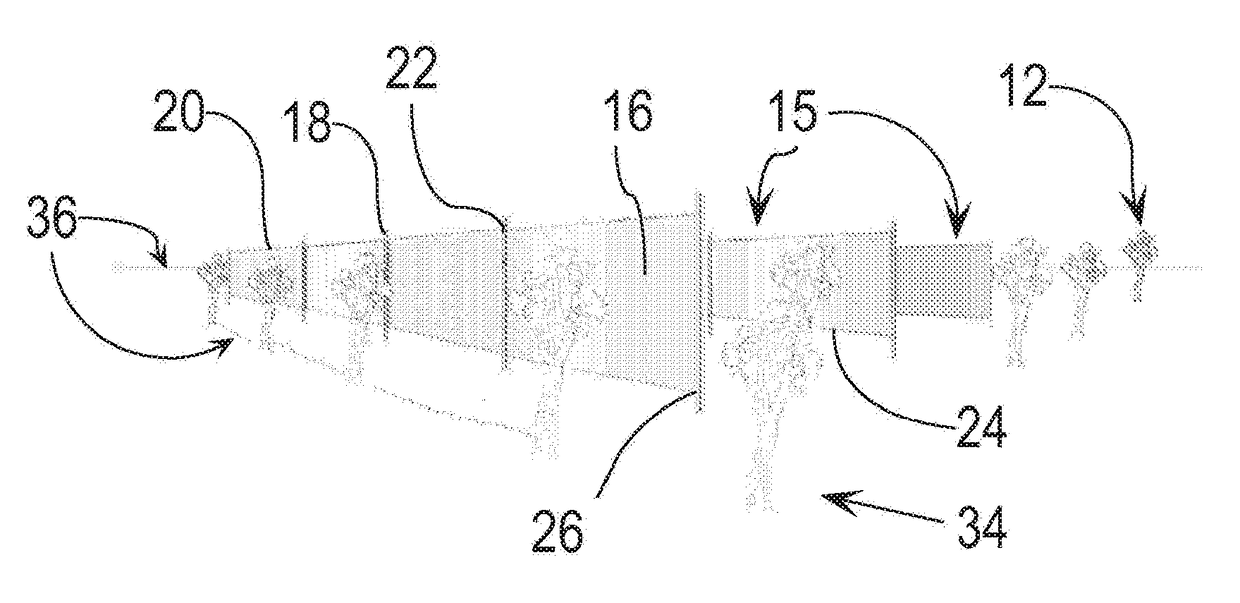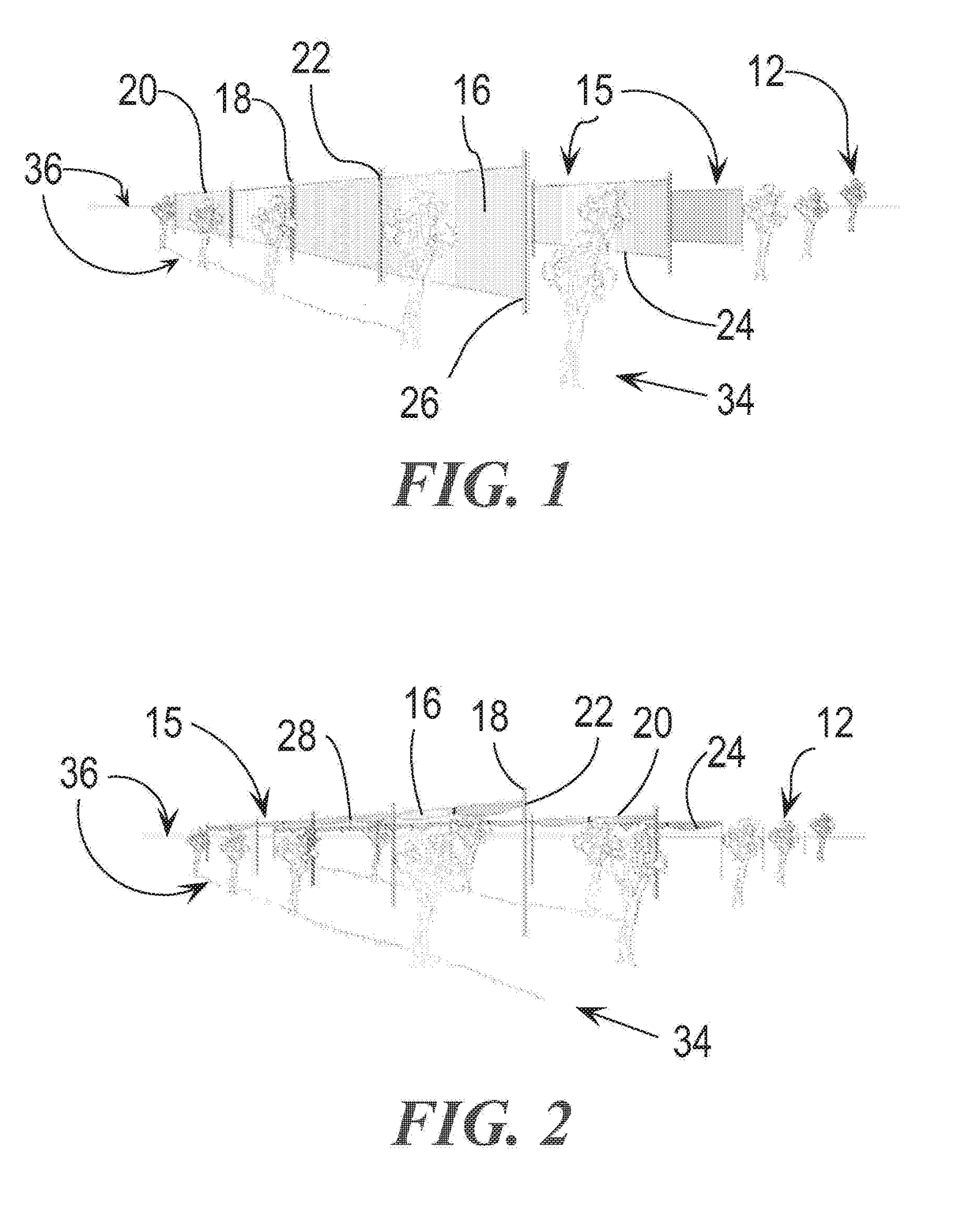Plant dormancy control system
a dormancy control and plant technology, applied in the field of dormancy control system, can solve the problems of delayed or inadequate foliation and flowering, delayed fruit production, and fruit production in non-commercial quantities or quality
- Summary
- Abstract
- Description
- Claims
- Application Information
AI Technical Summary
Benefits of technology
Problems solved by technology
Method used
Image
Examples
example 1
[0039]The plant dormancy control system 10 has been installed in cherry orchards to test the degree of plant dormancy control that can be achieved. In a test installation, the use of shade structures 15 was evaluated in terms of controlling cherry bud temperatures during the cherry tree dormancy period, with a maximum ambient temperature of 25° C. during the dormancy period, on typical sunny days. This data was collected between the hours of 10 am to 4 pm. The results of that experiment are set forth in Table 1 below
TABLE 1Shade + EvaporativeControl BudShade BudCooling BudTemperatureTemperatureTemperature25.4° C.16.9° C.15.2° C.26.4° C.19.4° C.15.3° C.30.1° C.22.5° C.21.5° C.32.0° C.25.2° C.21.2° C.29.8° C.22.5° C.18.0° C.31.3° C.23.9° C.22.2° C.31.6° C.24.3° C.22.8° C.
example 2
[0040]Further experiments were performed using control trees, shade structures 15 (“SE” in Table 2 below), evaporative cooling (“EC” in Table 2 below), and various chemical / hormone sprays like Dormex®, Thiadiazuron (TDZ) and Erger®. The results of those experiments are set forth in Table 2 below:
TABLE 2TreatmentTotal ProductionHarvest TimingNo Dormex ®0-5cherries per treeMay 8Early Dormex ®0-5cherries per treeLate Dormex ®5-50cherries per treeThiadiazuron (TDZ)0-50cherries per treeErger ®0-50cherries per treeEC + Early Dormex ®3-5ton / haApril 28SE + Early Dormex ®15-20ton / haSE + EC + Early Dormex ®15-20ton / haApril 20EC + TDZ3-5ton / haSE + TDZ25-30ton / haSE + EC + TDZ25-30ton / haApril 28EC + Erger ®4ton / haSE + Erger ®15ton / haSE + EC + Erger ®20ton / ha
The experimental results set forth in Table 2 demonstrate the relative ineffectiveness of the traditional dormancy control systems using chemical / hormone sprays, or sprays coupled with evaporative cooling. Using the traditional dormancy contr...
example 3
[0042]Further experiments were performed using two different cherry varieties (“Santina” and “Bing”) at different locations (Aculeo, Región Metropolitana, Chile and Rancagua, Región del Libertador Bernardo O'Higgins, Chile) during the year 2015. The tests were made including the shade structures 15 (“SE” in Tables 3 and 4 below), Dormex® at different percentages, Break® at a concentration of 20 cc / 100 L, Agricultural Oil at different percentages and / or CPPD® at a concentration of 15 ppm, wherein said products are traditionally used for controlling crops. The results of those experiments are set forth in Table 3 below for the yield and in Table 4 below for the harvest distribution per date:
TABLE 3Cherry varietyTreatment*Yield (Kg)Santina (Aculeo)Dormex 3% + Break 20 cc / 100 L1.895SE + Dormex 3% + Break 20 cc / 100 L12.075Dormex 4% + Break 20 cc / 100 L5.170SE + Dormex 4% + Break 20 cc / 100 L11.080Bing (Aculeo)Dormex 3% + Break 20 cc / 100 L1.464SE + Dormex 3% + Break 20 cc / 100 L3.380Dormex 1...
PUM
 Login to View More
Login to View More Abstract
Description
Claims
Application Information
 Login to View More
Login to View More - R&D Engineer
- R&D Manager
- IP Professional
- Industry Leading Data Capabilities
- Powerful AI technology
- Patent DNA Extraction
Browse by: Latest US Patents, China's latest patents, Technical Efficacy Thesaurus, Application Domain, Technology Topic, Popular Technical Reports.
© 2024 PatSnap. All rights reserved.Legal|Privacy policy|Modern Slavery Act Transparency Statement|Sitemap|About US| Contact US: help@patsnap.com










